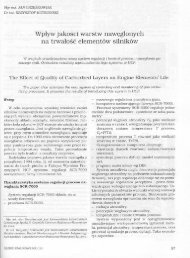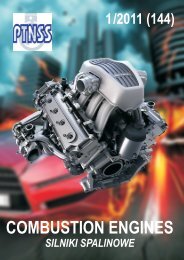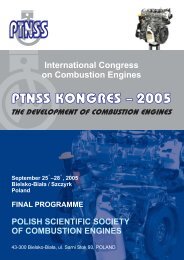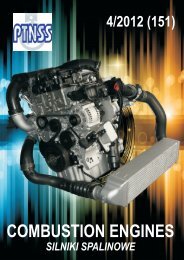You also want an ePaper? Increase the reach of your titles
YUMPU automatically turns print PDFs into web optimized ePapers that Google loves.
Experimental and modeling study of the gasoline HCCI engine with internal gas recirculation<br />
Although the air excess coefficient determines the exhaust<br />
gas temperature, it affects the temperature of the start<br />
of compression less significantly than the valve timing. A<br />
change in the temperatures of the exhaust gas retained in the<br />
cylinder is compensated by the changes in the density of the<br />
same. Therefore, the amount of exhaust gas retained in the<br />
cylinder and the amount of intake air also change.<br />
5. Conclusions<br />
This study presents experimental and simulation test<br />
results for a working cycle of a gasoline engine operating<br />
in the HCCI mode. The internal gas recirculation obtained<br />
from negative valve overlap was used for the increase in<br />
the temperature of the working medium. The following<br />
important conclusions result from the tests:<br />
1. In order to enable engine operation in the HCCI mode, an<br />
equilibrium between the amount of exhaust gas retained in<br />
the cylinder, temperature of the exhaust gas and the amount<br />
and temperature of the intake air has to be maintained.<br />
2. The attainable range of engine operation in the HCCI<br />
mode is limited by the temperature value as of closing of<br />
the intake valve (the temperature changes within a small<br />
range).<br />
3. The temperature of the closing of the intake valve results<br />
from the energy balance of the charge exchange process.<br />
In order to maintain an appropriate course of the charge<br />
exchange, it is necessary to select appropriate valve timing<br />
and valve lifts.<br />
5. Wnioski<br />
W niniejszym opracowaniu przedstawiono wyniki badań<br />
eksperymentalnych oraz symulacyjnych cyklu roboczego<br />
benzynowego silnika pracującego w trybie HCCI. Do podniesienia<br />
temperatury czynnika roboczego wykorzystano<br />
wewnętrzną recyrkulację spalin uzyskaną dzięki ujemnemu<br />
współotwarciu zaworów. Z przeprowadzonych badań wynikają<br />
ważne wnioski:<br />
1. Aby możliwa była praca silnika w trybie HCCI, musi<br />
być zachowana równowaga pomiędzy ilością spalin<br />
zatrzymywanych w cylindrze, ich temperaturą a ilością i<br />
temperaturą zasysanego powietrza.<br />
2. Osiągalny zakres pracy silnika w trybie HCCI jest ograniczony<br />
wartością temperatury w chwili zamknięcia zaworu<br />
dolotowego, która zmienia się w niewielkich granicach.<br />
3. Temperatura zamknięcia zaworu dolotowego wynika z<br />
bilansu energetycznego procesu wymiany ładunku. Aby<br />
zachować właściwy przebieg wymiany ładunku, konieczny<br />
jest odpowiedni dobór faz rozrządu oraz wzniosu<br />
zaworów.<br />
Bibliography/Literatura<br />
[1] Hunicz J., Kordos P.: An experimental study of fuel injection<br />
strategies in CAI gasoline engine. Experimental Thermal and<br />
Fluid Science, vol. 35, pp. 243-252, 2011.<br />
[2] Hunicz J., Kordos P.: Experimental study of the gasoline engine<br />
operated in spark ignition and controlled auto-ignition combustion<br />
modes, SAE Technical Paper 2009-01-2667, 2009.<br />
[3] Kozaczewski W.: Zmienne fazy rozrządu – nowe rozwiązania<br />
i silnik badawczy do badania ich wpływu. Journal of KONES<br />
Combustion Engines, vol. 8, No 3-4, pp. 182-187, 2001.<br />
[4] Najt P., Foster D.E.: Compression-ignited homogeneous charge<br />
combustion, SAE Technical Paper 830264, 1983.<br />
[5] Noguchi M., Tanaka Y., Tanaka T., Takeuchi Y.: A Study on<br />
gasoline engine combustion by observation of intermediate<br />
reactive products during combustion, SAE Technical Paper<br />
790840, 1979.<br />
[6] Stanglmaier R.H., Roberts Ch.E.: Homogeneous charge<br />
compression ignition (HCCI): benefits, compromises, and future<br />
engine applications, SAE Technical Paper 1999-01-3682,<br />
1999.<br />
[7] Wildman C., Scaringe R.J., Cheng W.K.: On the maximum<br />
pressure rise rate in boosted HCCI operation, SAE Technical<br />
Paper 2009-01-2727, 2009.<br />
[8] Wilson T.S., Xu H., Richardson S.: An experimental study of<br />
combustion initiation and development in an optical HCCI<br />
engine, SAE Technical Paper 2005-01-2129, 2005.<br />
[9] Yao M., Zheng Z., Liu H.: Progress and recent trends in homogeneous<br />
charge compression ignition (HCCI) engines, Progress<br />
in Energy and Combustion Science, vol. 35, pp. 398-437,<br />
2009.<br />
Jacek Hunicz, DSc., DEng. – doctor in the Faculty<br />
of Mechanical Engineering at Lublin University<br />
of Technology.<br />
Dr hab. inż. Jacek Hunicz – adiunkt na Wydziale<br />
Mechanicznym Politechniki Lubelskiej.<br />
e-mail: j.hunicz@pollub.pl<br />
Michał Gęca, MEng. – post-graduated student in<br />
the Faculty of Mechanical Engineering at Lublin<br />
University of Technology.<br />
Mgr inż. Michał Gęca – doktorant na Wydziale<br />
Mechanicznym Politechniki Lubelskiej.<br />
e-mail: michal.geca@pollub.pl<br />
<strong>COMBUSTION</strong> <strong>ENGINES</strong>, No. 1/2013 (152)<br />
9












